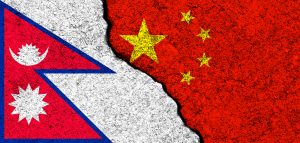Nepal’s newly appointed deputy prime minister and foreign minister, Narayan Kaji Shrestha, is in China on his first foreign visit from March 24 – April 1. The trip comes less than three weeks after the new government was formed in Nepal on March 4. The Chinese Ministry of Foreign Affairs and Chinese Communist Party (CCP) Politburo were quick to extend an invitation to the newly formed government, now led by a five-party Left Alliance.
As a country landlocked between two nuclear powers, India and China, Nepal’s foreign policy has been constrained by its geographical location. Historically, Kathmandu has enjoyed close diplomatic ties with India, marked by the 1950 Treaty of Peace and Friendship. An open border, sociocultural bonds, people-to-people ties, and no visa regime have further strengthened the bonds.
However, in the last decade, there has been a drastic shift in Nepal’s diplomatic consideration to deepen ties with its northern neighbor: China. The leftist parties – mainly the Communist Party of Nepal-Maoist Center and Communist Party of Nepal-Unified Marxist Leninist (CPN-UML), have advocated moving away from India’s longstanding centrality in Nepali foreign policy, which suits their political mandate and natural ideological bonds with China.
The alleged border blockade by India in 2015 over New Delhi’s reported unhappiness with Nepal’s new constitution and the ongoing border dispute over the Kalapani Region has contributed to a trust deficit in bilateral relations. China has left no stone unturned in exploiting the situation.
Soon after the CPN-UML took over the government in 2016, Prime Minister K.P. Sharma Oli went on a week-long China visit. Among several deals, the Transport, and Transit Agreement was at the heart of his China visit. It showcased Nepal’s intent to find alternative routes for its third-country trade and increase connectivity for better outreach with China.
The next year changed the course of China-Nepal ties as Beijing succeeded in getting Kathmandu to sign up to the Belt and Road Initiative (BRI) in May 2017. This was seen as a significant diplomatic loss for India, considering New Delhi had objected to the BRI since its inception because part of the China-Pakistan Economic Corridor traverses disputed territory.
China-Nepal ties received another high-profile boost with the visit of Chinese President Xi Jinping in September 2019. During his trip, bilateral ties were elevated from a “Comprehensive Partnership of Cooperation Featuring Ever-lasting Friendship” to a “Strategic Partnership of Cooperation Featuring Ever-lasting Friendship for Development and Prosperity.” It is still unclear whether Nepal has gained anything through the addition of “strategic” to the diplomatic mantra, but it was a win for China in letter and spirit.
Beijing has clearly established a bonhomie with left forces in Nepal. However, it has still been unable to defeat India’s central role in Nepali trade, transit, and transportation due to the geographical limitations presented by the mountainous terrain between China and Nepal. This has eventually led to the BRI failing on technical grounds. To date, nearly seven years after the deal was signed, not a single project has been launched under the BRI framework.
The much-hyped “Trans-Himalayan Multi-Dimensional Connectivity Network,” which includes a railway corridor across the Himalayas connecting Tibet to Kathmandu, has no takers in Nepal for one reason: Who will bear the cost? Nepal certainly cannot afford it. Kathmandu has repeatedly conveyed that it would like to fund the project using more grants than debt.
China’s financial assistance to Nepal has primarily been criticized as “debt-trap” diplomacy. China has consistently denied this, but it is difficult for Beijing to escape such concerns amid examples of default by recipients of China’s loans – including Sri Lanka in Nepal’s immediate neighborhood. Nepal, as a smaller neighbor of China, has its fears and wants to lessen the risks while engaging with China.
While Nepal’s other major political party, the Nepali Congress, has hesitated to engage more profoundly with China due to such concerns, the left parties have a limited bandwidth to resist China. They derive their “ultra-nationalistic” ideology from an anti-India and pro-China approach. Such a political constituency allows China to court Nepal on a larger scale, suiting its strategic needs.
Unfortunately, the political instability and short-term governments in Nepal keep Beijing’s Kathmandu plans on hold more than they are in action. Therefore, Beijing has tried to exploit smaller windows of engagement whenever a left-led government in Nepal exists. The current left alliance government in Nepal is one such opportunity for Beijing to explore the maximum.
While Shrestha is in China, Chinese leaders will seek to pursue the implementation of past accords, including the Belt and Road Initiative, which has been in cold storage since it was signed in May 2017.
Shrestha will also visit Tibet to reaffirm Nepal’s “One China” policy and its commitment to not allowing “Free Tibet” voices on its soil. China heavily focuses on the presence of Tibetan refugees in Nepal who escaped Communist Party rule in Tibet. Beijing worries that the “Free Tibet” movement in Nepal, led by the Tibetan community, harms its international stature on the human rights front and poses security threats to peace and stability in Tibet.

































